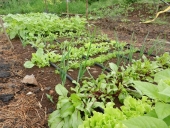
 1
1














Hello Troy: I provided the vines for the new arbor at Wheaton Lab so I have been asked to answer your questions. I encourage you to go to your profile in the upper right corner and edit it so that your location and or growing conditions are listed with your name when you post. With out that information it is hard to give you compleat answers.Troy Docimo) wrote: Okay this go around I want to get some help. In the future i would like to grow several types of grapes. Id like to grow them in high raised beds with a trellis behind it.)
Depends on your conditions. Their productivity is affected by having a good layer of forest floor type soil for the surface roots but they also send down deep roots for water and minerals so container beds are not recommended.)
1) How deep should the raised bed be?)
That is a good point to train the vine along a wire to the next post. Buds on the vine put out new growth each spring with one or more fruit clusters then more growth to which will repeat next year. I find it best to snap off the extra growth unless I want to extend that vine. I have mine at 8 feet high so the deer help doing that pruning. After harvest cut back unwanted growth to one or two buds.
2) If you have a one piece trellis going straight up (6ft above ground give or take), once the vines reach the top what do you do? Trim/Cut them? Wind them back down?
Research the soil that variety is known to be grown in. You can maintain a mulched surface or grow a surface layer of annuals or perennials.
3) I plan on each type of grape (Red, Green, Black etc...) but not sure of the specific ones. What components should my soil have? Place Mulch / Wood Chips on top of the soil?)
What ever you want to maintain. Grapes have a mandate for world domination; they will grow as far as they are allowed and if they detect a tree or something above they will jump to that and continue on up.
4) How far apart should each "Bed / Type of Grape" be?)
Depends on your climate conditions. If posible give them dormant time to establish root growth before they start to push sap to the growing buds. Avoid cutting a vine when it starts pushing sap to the buds or it will drip out a lot of sugars intended for new growth.
5) I'm probably not going to be able to plant in the fall as i hoped (is there a time too late to plant?) When should i plant (assuming bare roots)?

Hans Albert Quistorff, LMT projects on permies Hans Massage Qberry Farm magnet therapy gmail hquistorff
 3
3




This is all just my opinion based on a flawed memory


 2
2




 2
2




Joseph Lofthouse wrote:My experience with raised beds indicates that they generally harm the plants grown in them, except in specialized circumstances, such as blueberries needing acid soil, sweet potatoes needing more warmth, or trying to grow over swampy ground or bedrock.

|
An elephant? An actual elephant. Into the apartment. How is the floor still here. Hold this tiny ad:
The new kickstarter is now live!
https://www.kickstarter.com/projects/paulwheaton/garden-cards
|


